Install on a single server
TFS 2017 | TFS 2015
The simplest way to set up Azure DevOps Server is to put everything on a single server. To confirm that this configuration is appropriate for your team, see the hardware recommendations. If not, consider a dual-server or multiple-server configuration instead.
If you're upgrading from an earlier version, learn more about compatibility and getting started with your upgrade.
Prerequisites
Prepare a single computer that satisfies the system requirements.
If you don't plan to use SQL Server Express, set up a supported version of SQL Server. When you set up SQL Server for Azure DevOps on-premises, at a minimum install the Database Engine and Full-Text and Semantic Extractions for Search features.
We recommend that you use SQL Server Express only for personal or evaluation deployments. Paid copies of Azure DevOps on-premises include a SQL Server Standard license. For more information, see Azure DevOps Server pricing and Team Foundation Server pricing. If you use the included license, you can use it only for databases created with those products.
The account you use to configure the installation must be a member of the sysadmin server role in SQL Server.
Note
Installing Azure DevOps on-premises involves a complex set of operations that require a high degree of privilege. These operations include creating databases, provisioning logins for service accounts, and more. Technically, all that's required is:
Membership in the serveradmin role.
ALTER ANY LOGIN, CREATE ANY DATABASE, and VIEW ANY DEFINITION server-scoped permissions.
CONTROL permission on the master database.
Membership in the sysadmin server role confers all these memberships and permissions. It's the easiest way to ensure that configuration succeeds. If necessary, you can revoke these memberships and permissions after installation.
To support installation and configuration of the Search extension, you need to provide a user name and password. Installing and configuring Search supports Code, Work Item and Wiki search features. For more information, see Configure search.
Note
Search also requires Oracle Server JRE 8 (Update 60 or higher). You can download and install or update to the latest version by accepting the Oracle Binary Code License Agreement for Server JRE and selecting Configure. Note that this will set the JAVA_HOME environment variable to point to the Java installation directory, and that Server JRE does not provide automatic updates.
When configuring the application-tier you have a choice of web site settings. Review Web site settings to understand the choices and requirements.
Download and install
-
Download Azure DevOps Server through one of the following channels:
- Visual Studio Downloads, which is the simplest method (scroll down to All downloads, Azure DevOps Server 2019)
- Visual Studio Dev Essentials
- Volume Licensing Service Center
Start the installation.
The installer copies files onto your machine, and then starts the Azure DevOps Server Configuration Center.
You can configure your installation by choosing Start Wizard, or return at a later time and launch the Server Configuration Wizard wizard as described in the next section.

Configure using the Basic option
This section walks you through configuring your Azure DevOps Server using the Basic option. The Basic option is optimized for simplicity by using default options for most inputs. If you want full control over all inputs, choose the New Deployment - Advanced option instead.
Open the Azure DevOps Administration Console and choose Configure Installed Features to open the Server Configuration Wizard.
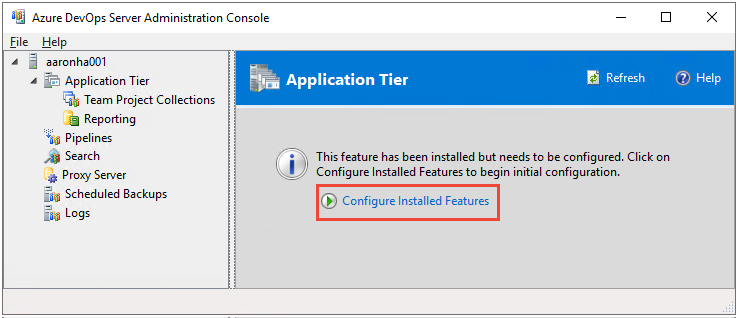
Choose Configure Azure DevOps Server and then choose Start Wizard.

Basic. Choose the New Deployment - Basic option and then choose Next.
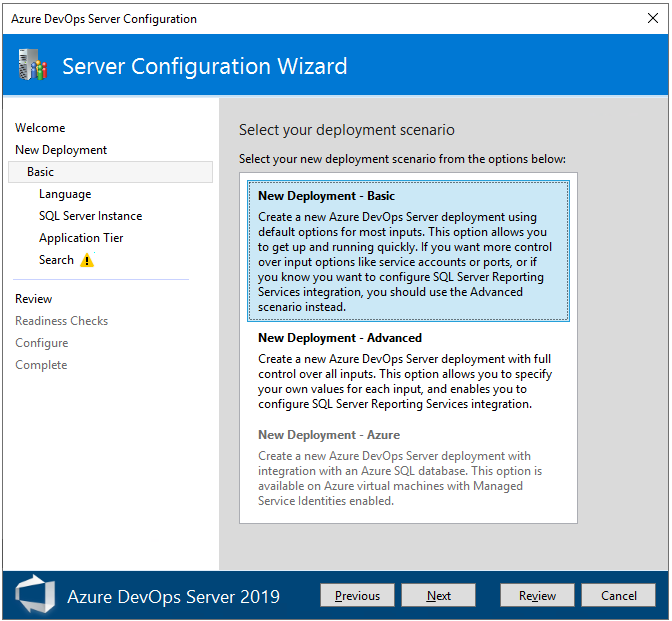
Language. Select the Language for your deployment and choose Next.
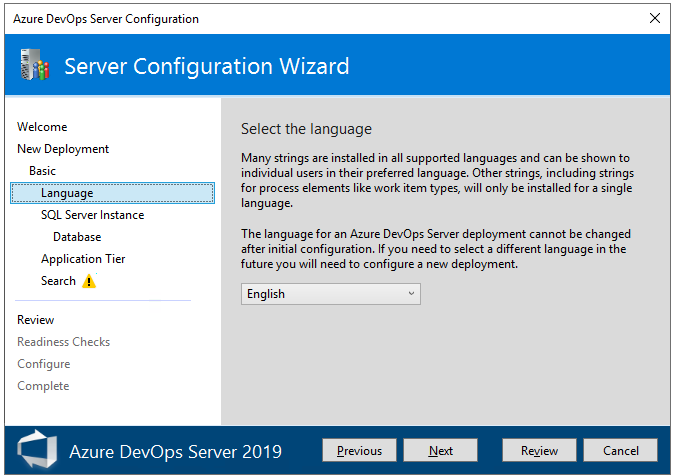
SQL Server Instance. Select the SQL Server instance you want to use. For evaluation purposes, choose Install SQL Server Express. For production purposes, choose Use an existing SQL Server Instance. Then, choose Next.
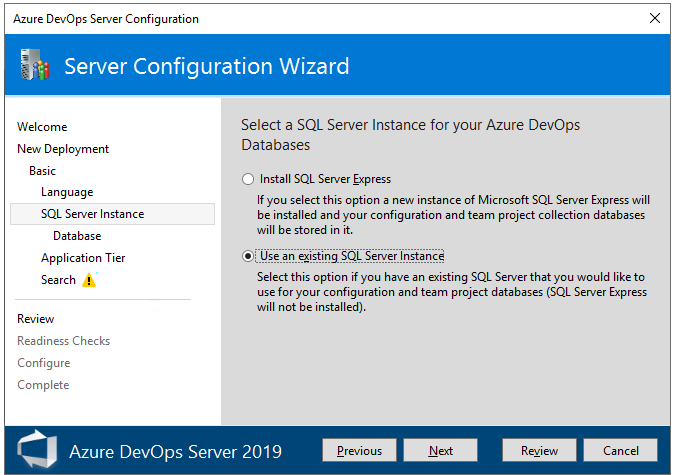
If you chose Use an existing SQL Server Instance, enter the database information in the next page and choose Test to verify. Then choose Next.
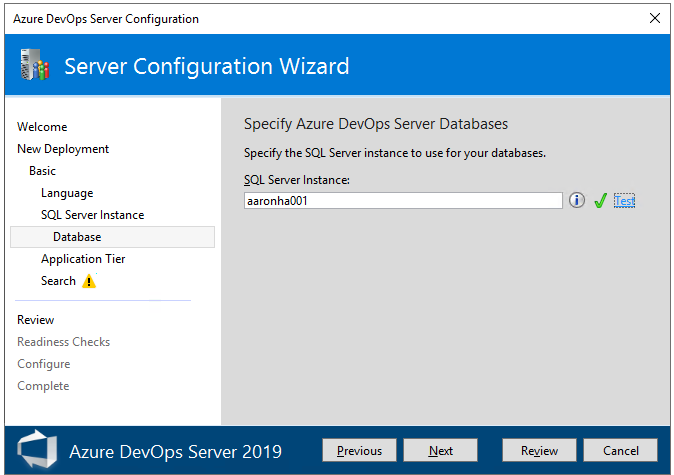
Application Tier. Choose the web site settings you want to use, which includes whether to use HTTP or HTTPS bindings, and then choose Next. For more information, see Web site settings.
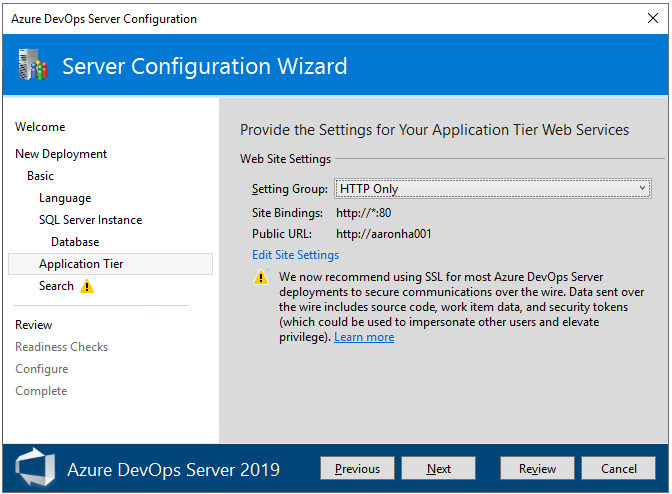
Search. Select whether to install and configure Search features or use an existing search service. Installing and configuring Search supports Code, Work Item and Wiki search features. For more information, see Configure search. Choose Next.
Review. Review your selections and choose Verify, the wizard runs readiness checks to validate your environment and your setting selections. If it's successful, you can configure your deployment. Otherwise, fix any errors and rerun the readiness checks.
Readiness Checks. When all checks have passed, you're ready to complete the configuration. Choose Configure.
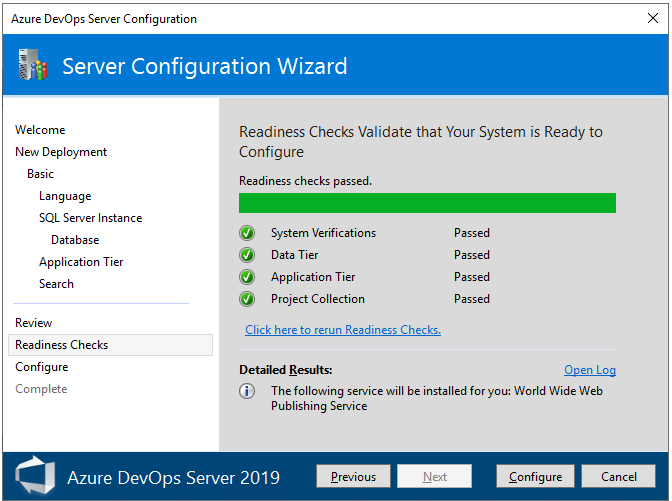
Tip
You can return to any previous page by choosing Previous or the page name in the left pane. If you change a configuration setting, then you need to verify the settings by choosing Click here to rerun readiness Checks.
Configure. The wizard starts configuring each feature and displays the progress. When complete, choose Next.
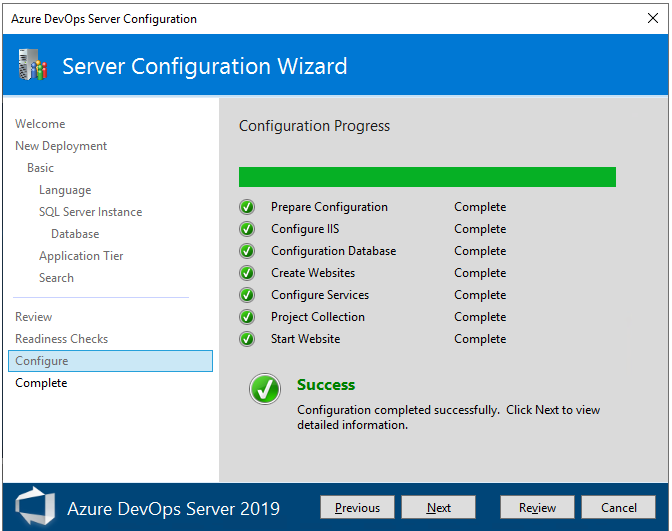
Complete. Review your configuration results and choose Copy Full Path to copy the link to the configuration log file. Choose the Azure DevOps Server link to open the web portal.
In this example, the link is
/http:aaronha001/.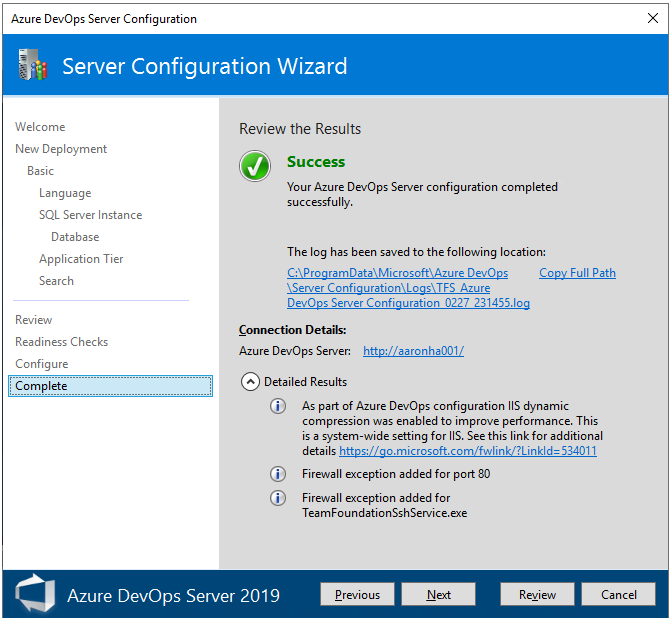
Configure using the Advanced option
This section walks you through configuring your Azure DevOps Server using the Advanced option. For a review of Basic and Advanced options, see Install and configure Azure DevOps, Basic and Advanced configuration options.
Start the Server Configuration Wizard to Configure Azure DevOps Server.

Choose Configure Azure DevOps Server and then choose Start Wizard.

Advanced. Choose the New Deployment - Advanced option and then choose Next.

Language. Select the Language for your deployment and choose Next.

Database. Specify the SQL Server instance you have set up for use with Azure DevOps Server. Then, choose Next.
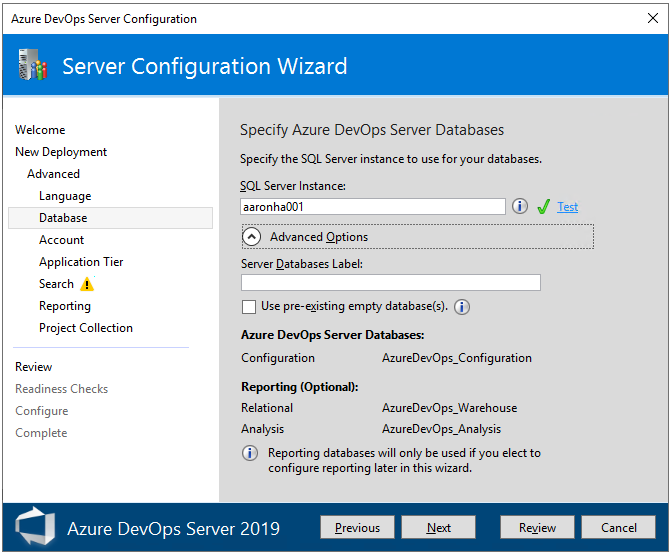
Account. Specify the service account to use.

Application Tier. Choose the web site settings you want to use, which includes whether to use HTTP or HTTPS bindings, and then choose Next. For more information, see Web site settings.
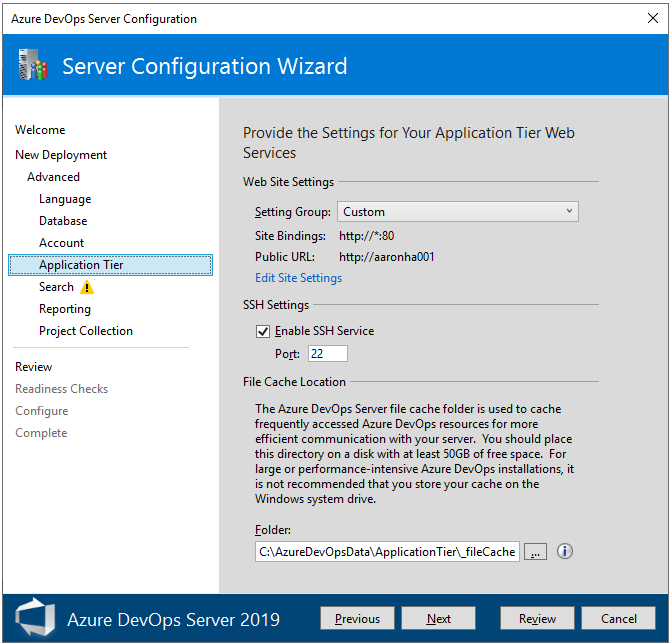
Search. Select whether to install and configure Search features or use an existing search service. Installing and configuring Search supports Code, Work Item and Wiki search features. For more information, see Configure search. Choose Next.
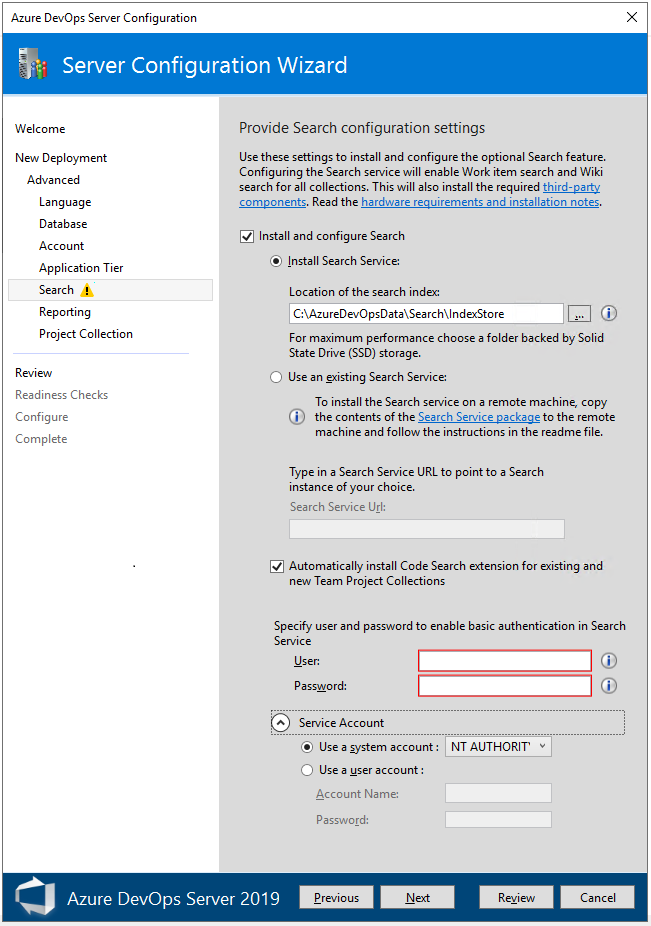
Reporting. Uncheck the Configure Reporting checkbox if you don't plan on using SQL Server Reporting Services or haven't yet installed SQL Server Analysis Services and SQL Server Reporting Services. Otherwise, keep the box checked and choose Next.

Reporting Services. Enter the name of the server where you installed SQL Server Reporting Services. Then, choose Populate URLs. Choose Next.
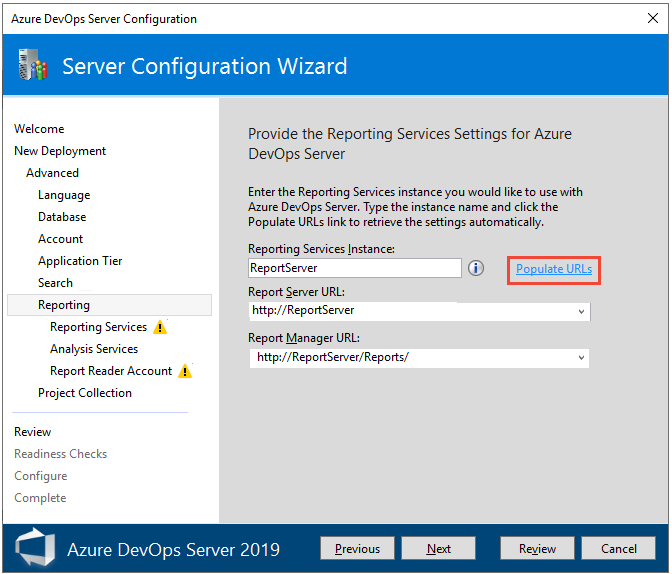
Analysis Services. Enter the name of the server where you installed SQL Server Reporting Services, and then choose Test. Choose Next.

Report Reader Account. Enter the credentials for the service account you've set up for reporting, and then choose Test. Choose Next.
Project Collection. Leave the Create a new team project collection checkbox checked. You must have at least one project collection in which to define projects. Leave the project name as is, DefaultCollection, or give it a new name and optionally a description.
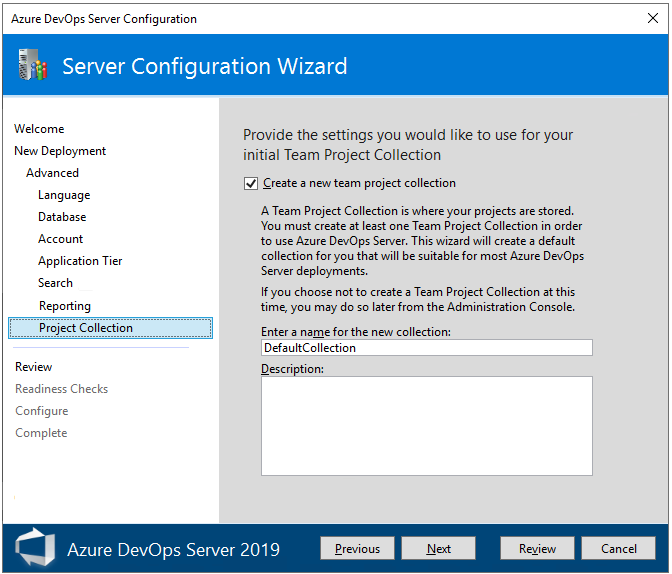
Review. Review the configuration settings you've made and choose Verify.
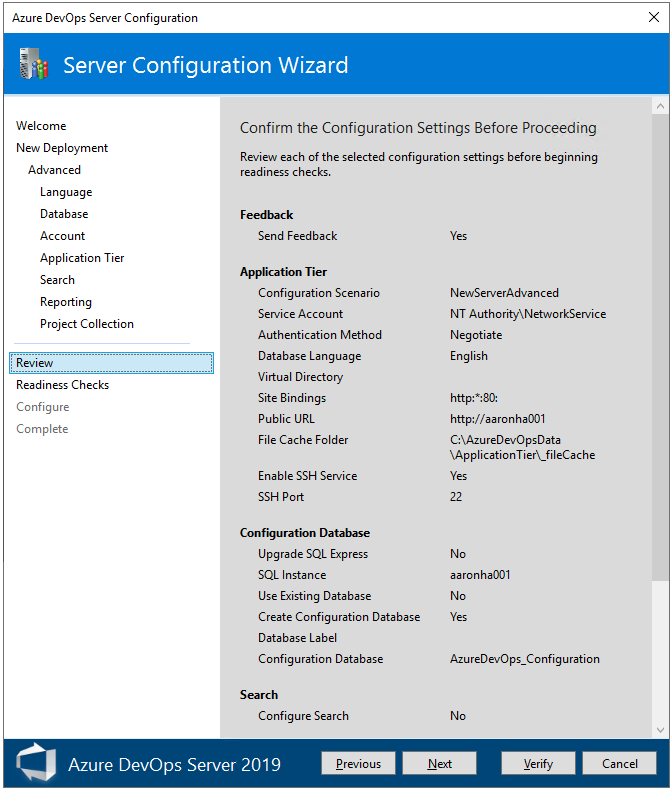
Readiness Checks. The system performs a final pass to ensure the configuration settings are valid. When all checks have passed, you're ready to complete the configuration. Choose Configure.
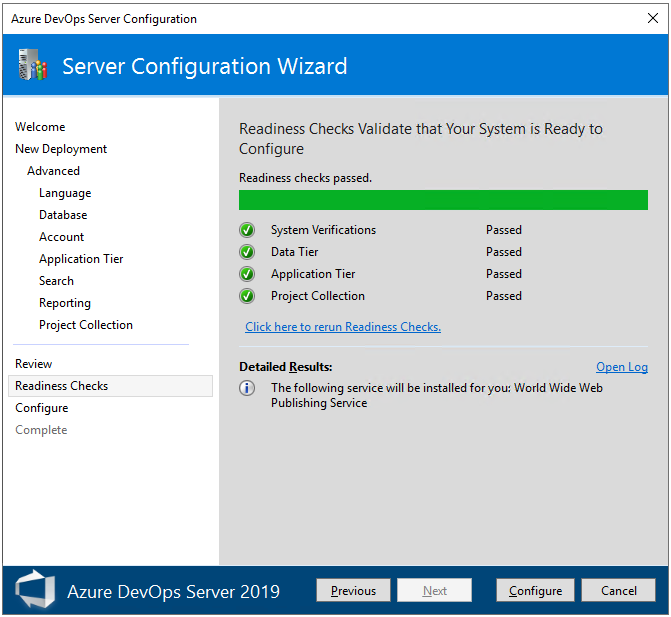
Tip
You can return to any previous page by choosing Previous or the page name in the left pane. If you change a configuration setting, then you need to verify the settings by choosing Click here to rerun readiness Checks.
Configure. The wizard starts configuring each feature and displays the progress. When complete, choose Next.
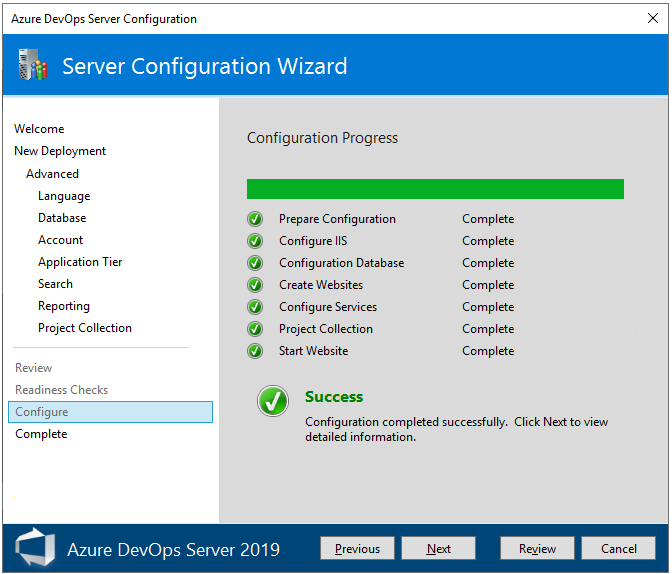
Complete. Review your configuration results and choose Copy Full Path to copy the link to the configuration log file. Choose the Azure DevOps Server link to open the web portal.
In this example, the link is
/http:aaronha001/.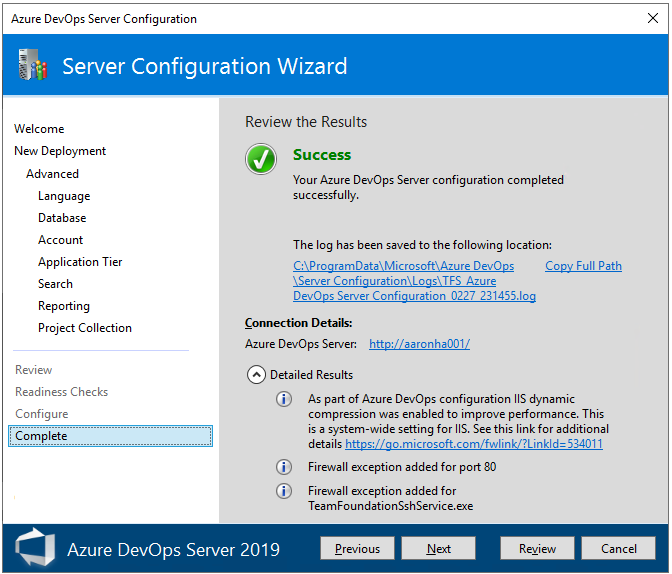
Create a project
Your web portal will open to the Create project page.
Provide a project name and optional description. The project name can't contain spaces or special characters (such as / : \ ~ & % ; @ ' " ? < > | # $ * } { , + = [ ]), can't begin with an underscore, can't begin or end with a period, and must be 64 characters or less.
The default settings configure a Git repository for version control and the Agile process for work tracking. To choose different options, expand Advanced.
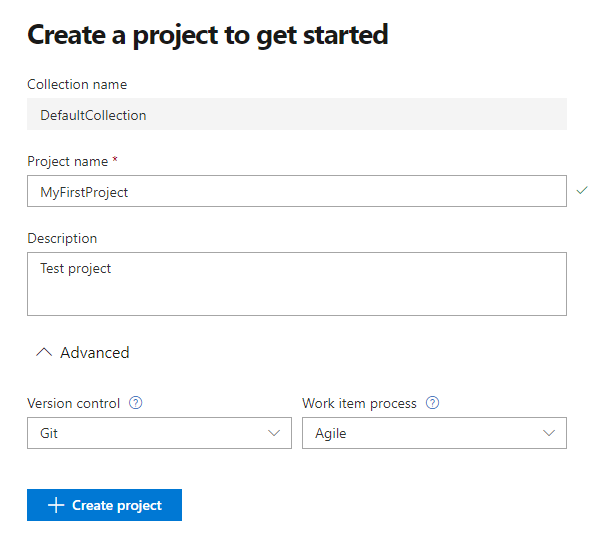
For a comparison of version control options, see Choose the right version control for your project. For a review of work tracking processes, see Choose a process.
When your project has been created, the project summary page appears. To learn more, see Share your project mission, view project activity.
Next steps
For administrators:
For developers: